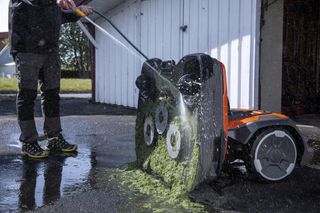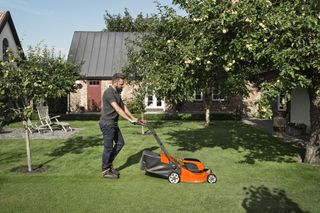
How to Clean & Maintain Your Husqvarna Mower | Lawn Mower Servicing
If you're like most people, you probably don't think much about lawn mower maintenance - until something goes wrong. And when something does go wrong, it's usually a hassle to try and fix it.
Whether it's a petrol mower, a battery-powered mower or a robot lawn mower, keeping them in the best condition possible will ensure they perform their very best for years to come. In this guide, we will look at how to clean and maintain the 3 most commonly owned types of lawn mowers, so that you can enjoy trouble-free mowing!
Signs your lawn mower needs cleaning
In a perfect world, you would clean your lawn mower after each use, removing caked-on cuttings, drying off any moisture and giving the blades a good wipe-down with mineral oil before you tuck it away. However, most people don't have time for this in the real world, and cleaning your mower is done only when absolutely necessary.
But when is it absolutely necessary? Here are a few things to look for, and if you are noticing any of them, it is probably time to give your mower a little bit of TLC!
- Your mower feels heavy or sluggish.
- You can hear a deep hum when the blades are spinning.
- Exhausted air feels hotter than usual, or you can't feel much air output.
- The chassis is caked in dry dirt and grass clippings.
- The blades are starting to look rusty or chipped.
- Your battery power is inconsistent.
Signs your mower needs servicing
When your mower is working as it should, it's all too easy to skip its annual servicing. Postponing by a few weeks won't be an issue, but annual mower servicing is something you want to remember to do for one good reason - it keeps your mower in the best working condition possible, saving you time and money on spares and repairs down the road.
How often your mower needs servicing can be found in the user manual for your model. However, there are times when your mower may need an early service, especially if you are noticing any of the following:
- Your lawn mower is having difficulty starting.
- Your mower is making loud knocking or rattling sounds.
- There's smoke coming from the mower.
- It shudders when mowing thick grass.
- There's a high-pitch whining sound when starting.
- There are more vibrations than usual.
- The mower is giving an uneven cut.
The easy way to clean a petrol lawn mower
The way you clean your mower will largely depend on the power supply and the type of mower you have. For the most part, electric and petrol push mowers follow the same types of cleaning with a few apparent differences such as petrol, oil, and fuel filters. For simplicity, we'll look at each of the basic steps to cleaning a lawn mower, going deeper into the different steps when needed.
- Place your mower on a level and secure surface such as a driveway or patio. If the mower is not on a flat surface, you run the risk of it tipping over as you work on it, which could cause injury.
- If your mower has a grass catcher, remove it and close the discharge flap to prevent any grass or debris from being pushed back inside during cleaning.
- To access the underside of your mower's deck, always tip your mower backwards towards the handles, never to its side. This will prevent oil and any fuel that may still be in the engine from seeping into places it shouldn't.
- Inspect the underside of the mower for any dried grass clippings that have built up. It is also a good idea to check the condition of the blades. Even if there is a small amount of debris on the mower deck, then you'll want to give it a wash while you have easy access to it.
- Most walk-behind mowers come with a fitting to attach a garden hose to flush the deck. If not, you'll want to turn your mower on its side and use gloved hands to remove the bulk of any grass, dirt, and debris.
- If your mower has a Hose fitting, turn the hose on, and then start the mower and let it run, allowing the water supply to clean the underside. After a few minutes, turn off the water and check the underside. Don't turn on the mower if you have to have it on its side to clean the blades.
- Repeat the process if there is any debris remaining. It's often a good idea to complete this cleaning task after each use before the grass clippings have a chance to dry and harden.
- Should the lawn mower's blades be a little blunt, then it might be time to replace them. Husqvarna does not recommend sharpening the blades on your mower. Check out Husqvarna's Lawn Mower Blade Replacement Guide for an in-depth look at how to change the blades.
- Keep the air filter clean by removing it and giving it a blast with some compressed air (never use liquid to clean your air filter!).
- Also, check and replace the spark plugs. You'll likely need to change the spark plugs every year or two, depending on use.
How to quickly clean a battery lawn mower
While many of the mower cleaning techniques will be similar between petrol and battery models, there are a few differences to be aware of. Here's how to safely clean down your battery-powered lawn mower.
- Place your lawn mower on a solid and level surface, turning it onto its side to access the cutting deck.
- Make sure the battery has been removed to prevent any accidental starts.
- Using a gloved hand or a washing-up brush, run around the underside of the cutting deck to remove the bulk of the dry grass and debris.
- For hard-to-reach areas, use compressed air to remove any debris. DO NOT use water on a battery mower - especially from a hose or pressure washer.
- To clean the chassis and cutting deck, take a damp cloth and wipe everything down.
- Clean the blades with an old toothbrush or hard bristle brush. If the blades are showing signs of damage, it may be time to replace them.
- Allow everything to dry properly before replacing the battery.
- To clean the battery, use a dry microfiber cloth to wipe down all surfaces and connection points - the same with the charger.

How to clean Husqvarna Automower®
It is highly recommended to have Automower® professionally serviced and cleaned at your local Husqvarna dealer at the end of every season. In between professional servicing, you can give Automower® a bit of TLC as and when you want.
Taking just 10-minutes of your time, Automower® is easy to keep in tip-top condition. It's important to note that you should never wash a robot or battery-powered mower with a pressure washer, running water or solvents. While designed to deal with surface water and rain, pressurised cleaning could force water into the electrics - which isn't something you want to do.
Regular annual servicing not only enables Automower® to work its best but also maintains the mower warranty.
- Begin by turning the main power switch to off.
- Put on a pair of protective gloves to prevent any accidental injuries.
- Place Automower® upside down, preferably on a sheet on a level surface.
- Remove the bulk of any clippings and dirt using your fingertips.
- Take an old toothbrush and gently clean the wheels, skid plate, body, etc.
- Return Automower® to its original position, gently shaking out any debris.
- Wipe down the chassis and all external body parts with a damp cloth.
- Dry everything off with a microfibre cloth when done.
- Turn on the main power switch and Automower® is good to go.
Ride-On/Zero-Turn/Garden Tractor
Husqvarna's range of Ride-On Front Mowers, Zero-Turn Mowers and Garden Tractors all have different servicing needs, and it's recommended you leave the bulk of the servicing and maintenance to a professional. However, there are a few things that you can do on a regular basis to keep your mower in good condition.
For mowers with inflatable tyres, make sure the pressure is kept at 16psi at all times. Checking them before use is a good routine to keep. Check the air intake valve before use and give it a clean out if it appears to be clogged; debris in the air intake can lead to an overheating engine which can cause serious damage. Check the mower's fluid levels before use each time. This includes oil levels, the hydraulic reservoir and radiator fluid. Top up any fluids that are low.
Check the air filter regularly. If it's noticeably dirty or the dust load indicator has turned red, you'll need to replace it, as a dirty air filter can lead to serious damage. Ensure the fuel filter is replaced after 800 hours of operation (at most). If you're noticing the engine stuttering or if the fuel supply seems to be an issue, it's a good idea to change the filter sooner.
The Husqvarna Dealer Advantage
When it comes to keeping your lawn mower in top condition, regardless of what kind you have, taking advantage of your local Husqvarna dealer’s experience and services is your best course of action.
Contact your local Husqvarna dealer to find out how using Husqvarna products and dealer services can improve your productivity around the garden.
View the full range online or drop by your local Husqvarna dealer today.